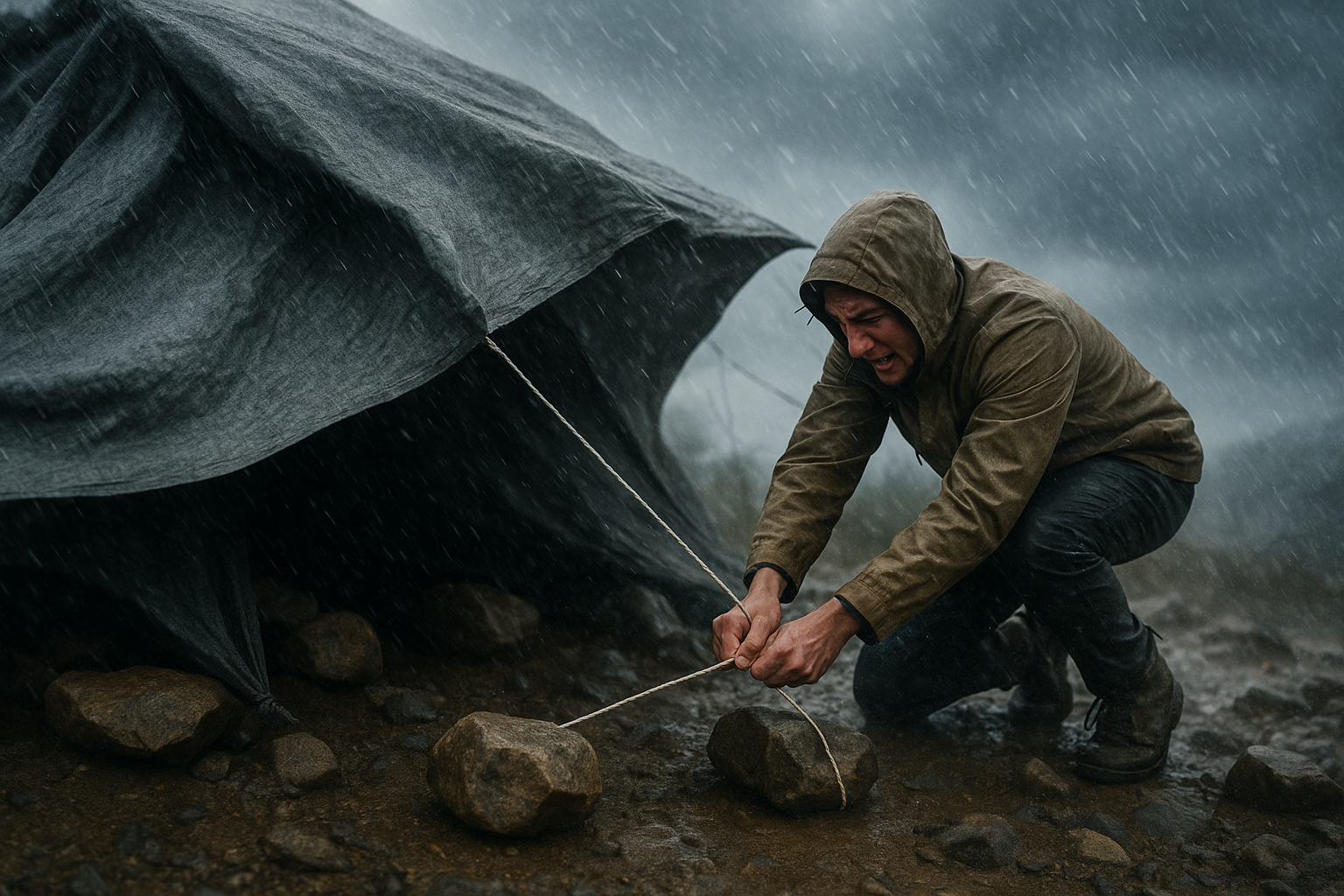It’s midnight. The wind is screaming like a freight train through the valley, slamming against the thin walls of your tent. The stakes you pounded in just hours ago are loosening in the saturated ground. The flysheet flaps like a dying bird. You’re soaked to the bone, hands numb, and if this shelter fails completely, you’ll be exposed to freezing rain, slicing wind, and a long, cold night of survival.
You never expected the storm to turn like this, but now, failure isn’t an option. This isn’t about comfort—it’s about staying alive.
The Real-World Pain of Windstorm Survival
Windstorms can escalate from annoying to life-threatening in minutes. Even experienced campers can underestimate how fast gusts exceeding 40 mph can flatten a tent. Saturated ground loses its grip on stakes, and wind pressure on a tent’s walls creates constant tugging forces. If the shelter collapses in these conditions, you’re not just facing discomfort. Hypothermia, exposure, and injury become real risks.
You’re wet. Cold. Tired. Alone. And you’ve got one shot to secure your shelter before the wind completely destroys it.
That’s where this clothesline and heavy stones trick—a lifesaving, field-tested hack—becomes your edge.
Why Regular Tent Pegs Fail in High Winds
- Ground Saturation: In storms, rain soaks the ground. Soil loosens, and tent pegs lose grip.
- High Wind Force: Wind gusts exert horizontal pull on the tent, yanking stakes from the ground.
- Stake Design Flaws: Many stock tent stakes are thin and short, not designed for extreme weather.
- Improper Anchoring: Without redundancy, a single point of failure (like one peg coming loose) can cause catastrophic collapse.
So what do you do when you’re in the middle of nowhere, with limited gear, no trees for support, and no time to waste?
Ingenious Field Hack: Clothesline and Stones as Emergency Anchors
This trick isn’t just clever—it’s a battle-tested survival tactic that’s saved countless campers from disaster. Here’s how to execute it with precision:
Step 1: Assess and Identify Critical Points
Identify the windward side of your shelter—the side taking the brunt of the storm. Look for weak points where stakes have loosened or tension is slackening. Focus on stabilizing these first.
Step 2: Deploy the Clothesline
Your clothesline (nylon or paracord) is about to become your lifeline. If you didn’t bring a dedicated clothesline, raid your gear for alternatives:
- Paracord (550-rated)
- Guyline rope
- Even a stripped length of gear cordage or shoelaces tied together
Wrap the line around the tent’s anchor points or pole bases—not just the flysheet—to ensure direct tension on the shelter’s frame. Create multiple attachment points if possible to distribute force.
Step 3: Locate Heavy Stones or Improvised Weights
Scour the campsite for heavy stones, boulders, or even packed bags filled with sand or soil. In an emergency, your water containers or heavy cookware can serve as weights. The key is mass—you need something heavy enough to resist lateral force.
Step 4: Tie and Secure
Loop the clothesline around the stones, tying a figure-eight follow-through or even a truckers’ hitch for maximum tension. Pull the line taut, anchoring it at a low angle to the ground to counteract uplift.
- Low Angle = More Stability: Aim for a 30-degree angle or less to ground level.
- Multiple Points = Redundancy: Use several lines and stones along the windward edge of the shelter.
Step 5: Tension the Line Hard
Pull the clothesline as tight as you can manage. If you have a ratchet strap or mechanical tensioner, use it. Otherwise, create a loop and twist a stick into it to create a windlass, tightening the cord without requiring brute strength.
Pro Tips: Level-Up Your Emergency Shelter Security
- Use Ground-Level Anchors: Instead of upright pegs, run the line low and horizontal to spread wind force along the ground.
- Fill Drybags as Anchors: If no rocks are nearby, fill your drybag with water or wet sand to create a heavy, portable weight.
- Double-Loop Weak Points: Wrap the clothesline twice around pole bases for added friction and security.
- Stack Rocks Over Lines: Place smaller rocks atop the clothesline near the anchor point for additional friction.
Field Anecdote: How This Trick Saved a Winter Camp
I once camped on a wind-exposed ridge in the Rockies. As night fell, 50 mph gusts shredded tents around me. One camper’s shelter collapsed completely, forcing him to huddle under a tarp. I grabbed my clothesline, wrapped it around the windward side of my tent’s base poles, and tied it to three large boulders I dragged into place. I used a double half-hitch and a makeshift windlass with a broken trekking pole. The wind howled all night, but my shelter held. Without that quick thinking, I might’ve been found hypothermic by sunrise.
What If You Don’t Have a Clothesline?
- Bootlaces or Belt: Tie them together to create an improvised line.
- Inner Tent Guyline: Use guylines from the tent’s own gear, re-routing them to the weighted anchors.
- Paracord Bracelet: If you wear one, unravel it into usable cordage.
Why This Hack Works in Real Emergencies
- Shifts from Vertical to Horizontal Tension: Instead of relying on stakes pulling up from the ground, you create horizontal force anchored by mass.
- Improvises with Field Materials: Uses what’s available—stones, gear, cordage—to solve the immediate threat.
- Fast Setup in Crisis: Takes under 10 minutes if done under pressure.
- Low Profile, High Security: No trees needed; no noisy, high-visibility methods.
When to Use This Trick
This isn’t a “nice to know” trick—it’s a must-know for:
- High-altitude camps with loose soil or rock.
- Coastal campsites where sand and wind make stakes unreliable.
- Emergency situations when standard gear fails or is lost.
- Solo camping where collapse could mean exposure.
Beyond the Trick: Prepare for Next Time
Survival camping isn’t about improvising after failure—it’s about anticipating the failure. Here’s what to pack and plan for your next trip:
- Pack a dedicated paracord line (550 cord)—at least 25 feet.
- Carry a lightweight mini-tensioner or carabiner for instant rigging.
- Learn basic knots: figure-eight, trucker’s hitch, and taut-line hitch.
- Scout anchorable terrain before setting up your shelter.
Conclusion: It’s Not About Comfort—It’s About Survival
When storm winds rip at your camp and failure feels inevitable, don’t wait for collapse. The clothesline and heavy stones trick is a literal lifeline—a method that can turn desperation into stability when the night turns brutal.
Remember: in a survival scenario, it’s not about the perfect gear or textbook setup. It’s about field ingenuity, mental clarity, and action under pressure. Secure your shelter fast, lock down the essentials, and live to see the sunrise.
Next time you head out, pack a clothesline. It might just save your life.

